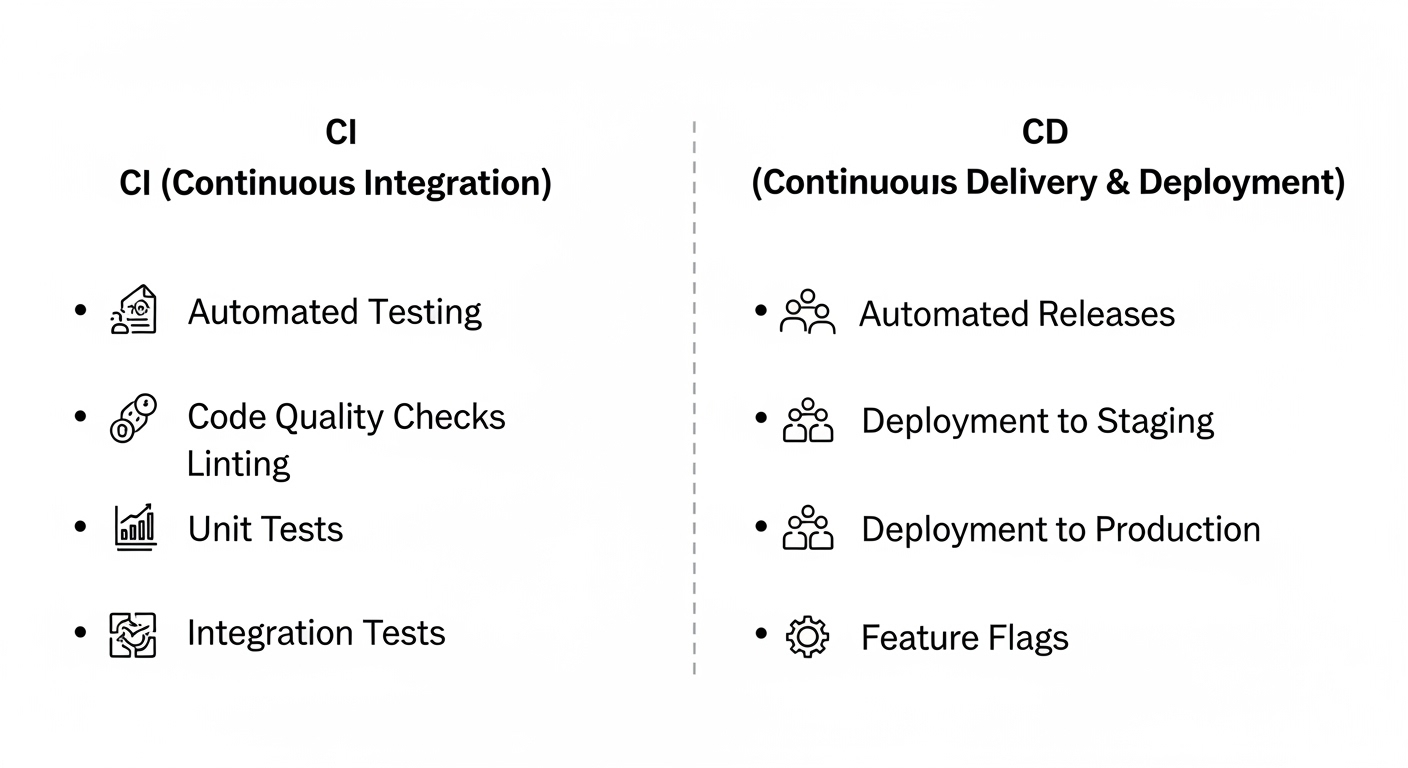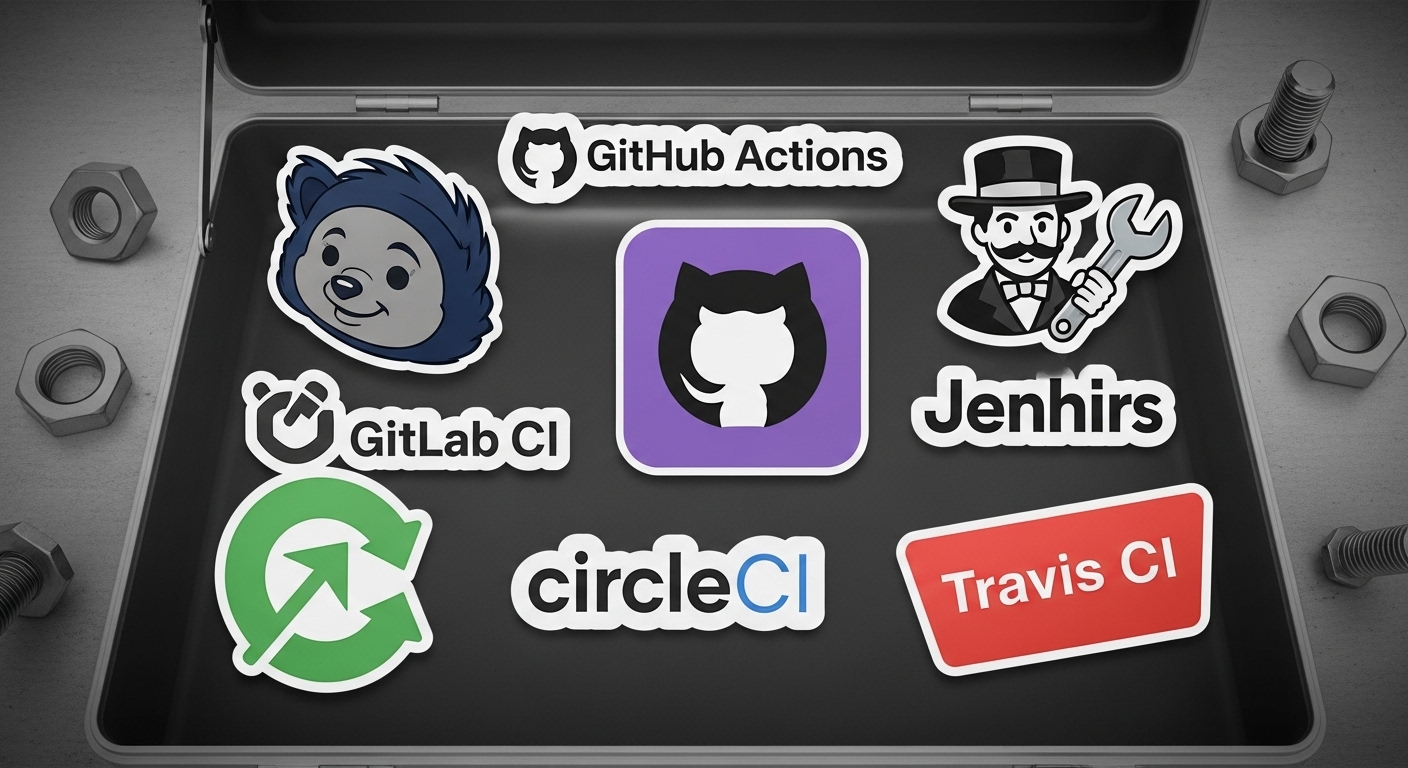What is a CI/CD Pipeline? Simple Explanation for Beginners

Imagine you are working on a project with a few other developers. Everyone writes code, pushes changes, and then… chaos. Someone forgets to test, someone else breaks a dependency, and another person pushes code that works locally but not in production. Without a system, every release feels like gambling.
A CI/CD pipeline solves that problem. CI stands for Continuous Integration, and CD stands for Continuous Delivery or Continuous Deployment. At its core, it’s an automated assembly line for your software. Each time you commit code, the pipeline takes over: it builds your project, runs tests, packages it, deploys it, and keeps an eye on it in production. That’s the big picture.
CI/CD Pipeline Explained Step by Step
Here is what typically happens:
You push code to GitHub. A pipeline tool like GitHub Actions, GitLab CI, or Jenkins notices the push. It kicks off a build, compiles the code, runs automated tests, and checks for issues. If everything looks good, the pipeline moves to deployment. It pushes your app to staging or production automatically. Finally, monitoring tools keep track of how it’s doing.
Without this chain, teams waste hours on repetitive manual tasks. With it, you can ship faster and sleep better at night.

Benefits of CI/CD Pipelines for Developers and Teams
-
The obvious win is speed. You can release features more often because you’re not stuck babysitting builds.
-
The second is confidence. Automated tests mean you don’t need to worry if a commit silently broke a function two layers deep.
-
The third is teamwork. Everyone merges into a shared branch regularly, so you avoid the nightmare of giant merge conflicts after weeks of separate work.
-
The last one is reliability. Your deployment steps live in code. That means no more “it works on my machine” excuses because the process is consistent every time.
The 5 Key Stages of a CI/CD Pipeline (Code, Build, Test, Deploy, Monitor)
Code Developers write and commit changes. Example: you push updates to a React app on GitHub.
Build The code is compiled or packaged. A Node.js app might run npm install and npm run build.
Test Automated checks confirm nothing broke. Maybe you run Jest for unit tests or Cypress for end-to-end tests.
Deploy The tested build moves to staging or production. This could mean uploading a Docker image to AWS ECS.
Monitor Once live, you track performance and errors. Tools like Prometheus and Grafana keep you in the loop.
CI/CD Pipeline Example with GitHub Actions and Deployment
Let’s take a simple case. You have a Node.js API on GitHub, and you want it deployed automatically when you push to main. Here’s a minimal GitHub Actions workflow:
name: Node.js CI/CD
on: push: branches: ["main"]
jobs: build-test-deploy: runs-on: ubuntu-latest
steps: - uses: actions/checkout@v3 - name: Install dependencies run: npm install - name: Run tests run: npm test - name: Build app run: npm run build - name: Deploy to server run: ssh user@server "cd /app && git pull && npm install && pm2 restart all"Every push triggers this file. It checks out your code, installs dependencies, runs tests, builds it, and deploys to your server over SSH.
That’s CI/CD in action: no manual copying files or late-night “it’s down again” moments.
Best CI/CD Tools Compared (Jenkins, GitHub Actions, GitLab CI, CircleCI)
You don’t need to reinvent the wheel. There are mature tools to choose from, each with strengths.
GitHub Actions
-
Integrated with GitHub repos.
-
Easy to set up with YAML workflows.
-
Best for small to medium teams.
GitLab CI/CD
-
Built directly into GitLab.
-
Strong pipeline visualization.
-
Popular in open-source and DevOps-heavy teams.
Jenkins
-
Highly customizable and extensible.
-
Massive plugin ecosystem.
-
Best for large enterprises with complex needs.
CircleCI
-
Cloud-first with good performance.
-
Simple config for most projects.
-
Strong integrations with Docker and Kubernetes.
Bitbucket Pipelines
-
Tight integration with Bitbucket.
-
Lightweight and easy to start.
-
Limited compared to GitHub Actions or GitLab.
The right tool depends on where your code lives, your team’s size, and how complex your deployments are.

Common CI/CD Pipeline Problems and How to Avoid Them
Flaky tests
Tests that pass sometimes and fail other times erode trust. Solution: isolate test environments, mock external services, and retry strategically.
Slow builds A pipeline that takes 30 minutes kills productivity. Speed it up with caching, parallel jobs, and only running what changed.
Secrets management Hardcoding API keys or database passwords is a disaster waiting to happen. Use secret managers or environment variables provided by the CI/CD tool.
Deploying broken code Sometimes pipelines deploy successfully but the app crashes in production. Solution: add health checks, rollback steps, and staging environments.
CI/CD Case Study: Automating Deployment with GitHub and AWS
Here’s a real scenario. A small team is building a Django app. They want every push to main to deploy automatically to AWS ECS.
They set up a GitHub Actions workflow. It builds a Docker image of the Django app, pushes it to Amazon Elastic Container Registry, and tells ECS to pull the latest version.
The result? Every feature or bugfix merged into main hits production in under ten minutes. The team no longer needs to coordinate manual deploys, and they catch issues quickly since monitoring tools alert them right away.
That’s the kind of payoff pipelines bring.
CI/CD Pipeline Best Practices for Faster, Safer Releases
-
Keep your pipelines fast. A pipeline that runs in under ten minutes encourages developers to push often.
-
Fail fast. If tests fail, stop the pipeline immediately instead of wasting time running later stages.
-
Secure your pipeline. Encrypt secrets, limit who can trigger deployments, and audit configs regularly.
-
Mirror production in staging. Bugs often appear because staging is nothing like production. Keep them close so surprises are rare.
-
Use feature flags. Instead of long-lived branches, merge code early and toggle features on or off in production.
How to Build a CI/CD Pipeline that Scales with Your Team
Start simple. A basic pipeline that builds, tests, and deploys is better than none.
As your team grows, expand. Add parallel test suites, container builds, and automated rollbacks. Use infrastructure as code so environments stay consistent.
The goal isn’t complexity. It’s trust. A good pipeline makes developers confident that pushing code won’t break everything.
And when that confidence spreads, your team can move faster, focus on features, and actually enjoy shipping softwares.
Windframe is an AI visual editor for rapidly building stunning web UIs & websites
Start building stunning web UIs & websites!
